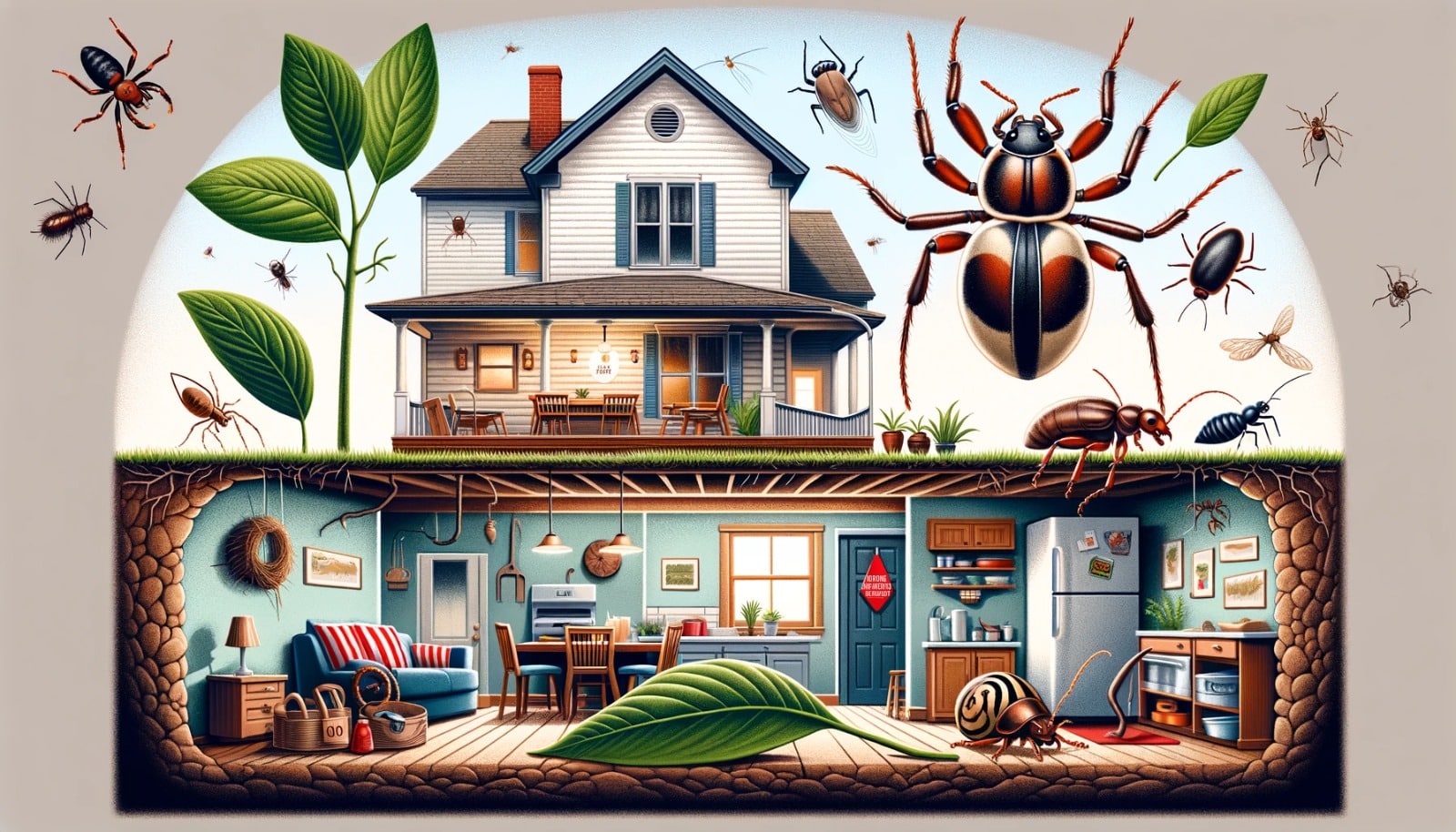Discovering a line of ants marching through your kitchen or hearing the eerie sound of something scuttling in the walls at night can be distressing experiences for any Ohio homeowner. These instances are more than just minor inconveniences; they signify the presence of household pests that are common in the Buckeye State. This guide delves into the common household pests in Ohio, offering insights on identification, understanding, and management, to ensure your home remains a sanctuary, free from unwanted intruders.
Common House Bugs in Ohio
Ohio’s diverse climate sets the stage for a variety of house bugs, each with their own unique behaviours and habitats. Ants are one of the most common pests in Ohio homes. From the tiny pavement ants to the larger carpenter ants, these insects are often drawn to food remnants and sugary spills in kitchens.

Bugs in Ohio? We’ve Got You Covered!
Spiders, while beneficial in controlling other insects, can become a nuisance when they invade living spaces. Ohio houses various spider species, ranging from the harmless common house spider to the more concerning brown recluse. Their presence often indicates other underlying pest issues, as spiders feed on insects.
Cockroaches are another major concern in Ohio. These pests are not only a sign of unsanitary conditions but also pose health risks by spreading bacteria and triggering allergies. The German cockroach and the American cockroach are frequently found in Ohio homes, lurking in kitchens, bathrooms, and other dark, moist areas.
Bed bugs, with their notorious reputation, are a growing issue in many Ohio residences. These tiny, nocturnal pests feed on human blood and are known for their rapid reproduction and resilience. Dealing with bed bugs often requires a multi-faceted approach, including thorough cleaning, heat treatment, and sometimes professional intervention.
Identifying Common House Bugs in Ohio
Effectively managing pests starts with accurate identification. Each species of house bug in Ohio has distinct characteristics that dictate the best approach for control. For instance, understanding the difference between carpenter ants and pavement ants is crucial, as the former can cause structural damage to wood in homes.
Physical attributes such as size, colour, and shape are key in identifying different pests. For example, bed bugs are small, reddish-brown insects with flat, oval bodies, while cockroaches are larger and have a more elongated shape. Behavioural patterns also provide important clues; ants follow pheromone trails and are commonly seen in lines, whereas bed bugs are elusive and primarily active at night.
Homeowners can benefit from resources like Pest Share’s identification guides, which offer detailed information and images to help distinguish between different pests. These resources can be invaluable in determining the right course of action for effective pest control.
Common Insects in Ohio
Beyond the typical house bugs, Ohio homes play host to a range of other common insects. Flies and mosquitoes are frequent visitors, especially during the warmer months. These insects not only cause annoyance but can also pose health risks by spreading diseases.
Crickets and earwigs are other common insects in Ohio. Crickets are known for their chirping sound, which can become a nuisance, especially at night. Earwigs, with their distinctive pincers, prefer moist environments and often invade basements and bathrooms.
Understanding the specific needs and behaviours of these insects is crucial in preventing and controlling their presence in homes. For instance, eliminating standing water and ensuring proper sealing of doors and windows can significantly reduce the entry of flies and mosquitoes.
The variety of common insects in Ohio homes requires a comprehensive approach to pest management. Accurate identification of these pests is essential, followed by targeted control methods. Homeowners should remain vigilant and proactive in implementing preventive measures to ensure their homes remain comfortable and pest-free.
Ohio Centipedes and Millipedes
The sight of centipedes and millipedes in Ohio homes often triggers a shiver down the spine of many homeowners. These multi-legged creatures, while generally harmless, can be quite unsettling due to their appearance and rapid movements.
Centipedes, known for their elongated bodies and numerous legs, are predatory and feed on other household pests like insects and spiders. This makes them beneficial in controlling other pest populations, though their presence is often not welcomed by homeowners. They prefer moist, dark environments such as basements, bathrooms, and under sinks.
Millipedes, in contrast, are decomposers. They have a more rounded body and feed on decaying organic matter. Unlike centipedes, they are not predators and are harmless to humans. Millipedes are often found in areas with high moisture and organic material, such as mulched flower beds or compost piles. When they venture into homes, it’s usually in search of moisture.
Control of these creatures involves reducing moisture and removing their habitats. This includes fixing leaks, ensuring proper ventilation, and removing piles of debris or leaves where they may nest. Chemical control is rarely necessary for centipedes and millipedes, as physical removal and habitat modification are usually effective.
Silverfish in Ohio

Silverfish are another common pest found in Ohio homes. These small, wingless insects are known for their silvery-grey colour and fish-like movements. They are nocturnal and thrive in humid environments, making basements, attics, and bathrooms their preferred habitats.
Silverfish feed on carbohydrates, particularly sugars and starches. This diet means they are often found in areas where books, wallpaper, or clothing are stored, as they are attracted to the glue and fabrics. While they don’t pose a direct health risk to humans, they can cause damage to personal belongings.
Preventing silverfish infestations involves reducing humidity in the home. This can be achieved through the use of dehumidifiers, proper ventilation, and fixing leaks. Regular cleaning and vacuuming can also help by removing potential food sources. For persistent silverfish problems, Pest Share offers targeted solutions that safely and effectively eliminate these pests.
Beetles Native to Ohio
Ohio is home to a variety of beetle species, some of which can become household pests. Carpet beetles and pantry beetles are among the most common beetles that invade Ohio homes.
Carpet beetles are small, oval-shaped insects that feed on a variety of animal-based materials like wool, silk, leather, and fur. They can cause significant damage to carpets, clothing, and upholstered furniture. Identifying and removing the source of the infestation is key in controlling carpet beetles. Regular vacuuming and cleaning, along with proper storage of susceptible materials, are effective preventive measures.
Pantry beetles, including the cigarette beetle and the drugstore beetle, invade kitchens and pantries, feeding on a wide range of stored food products. Keeping pantry items in sealed containers and regularly cleaning shelves can help prevent infestations. Discarding infested food products is crucial in controlling these pests.
Both carpet and pantry beetles can be challenging to control once they establish themselves in a home. Pest Share’s expertise in identifying and eliminating these beetles can be invaluable in ensuring your home remains free from these unwelcome guests.
Preventive Measures and Control Strategies
Maintaining a pest-free home in Ohio requires a proactive approach, focusing on preventive measures and effective control strategies. Simple steps can significantly reduce the likelihood of pest infestations.
Regular home maintenance is crucial. This includes sealing gaps and cracks in walls, windows, and doors to prevent entry. Keeping the home clean and free of food crumbs and spills is essential, especially in the kitchen. Proper food storage, using sealed containers, can deter many pests, particularly those attracted to pantry items.
Reducing moisture in the home is also key. Using dehumidifiers, repairing leaky pipes, and ensuring good ventilation can help control pests that thrive in humid environments, like silverfish and millipedes. Regularly cleaning and decluttering areas like basements, attics, and garages reduce potential habitats for pests.
For homeowners facing persistent or large-scale infestations, DIY methods might not be sufficient. This is where professional pest control services, like Pest Share, can be invaluable. Their expertise and tailored solutions provide effective and long-lasting results.
When to Seek Professional Help
Recognizing when a pest problem is beyond DIY solutions is crucial. Large infestations, hard-to-eliminate pests like bed bugs or termites, or potentially dangerous insects such as venomous spiders, warrant professional intervention.
Pest Share offers specialised services for these challenging scenarios. Their experts use advanced methods and tools to safely and effectively tackle even the toughest pest problems. From initial assessment to treatment and follow-up, their comprehensive approach ensures thorough eradication and prevention of future infestations.
Conclusion
Battling bugs in the Buckeye State doesn’t have to be a daunting task. Armed with the right knowledge and strategies, you can keep your Ohio home pest-free. Remember, prevention is key, but when pests persist, don’t hesitate to call in the pros. Pest Share is here to help you every step of the way, from identification to eradication. So, ready to reclaim your peaceful, pest-free living space? Give Pest Share a call and take the first step towards a serene home environment.





